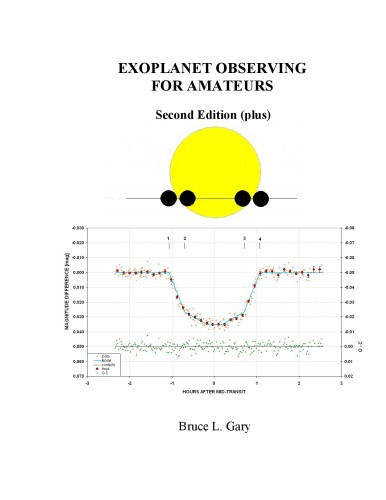

Most ebook files are in PDF format, so you can easily read them using various software such as Foxit Reader or directly on the Google Chrome browser.
Some ebook files are released by publishers in other formats such as .awz, .mobi, .epub, .fb2, etc. You may need to install specific software to read these formats on mobile/PC, such as Calibre.
Please read the tutorial at this link. https://ebooknice.com/page/post?id=faq
We offer FREE conversion to the popular formats you request; however, this may take some time. Therefore, right after payment, please email us, and we will try to provide the service as quickly as possible.
For some exceptional file formats or broken links (if any), please refrain from opening any disputes. Instead, email us first, and we will try to assist within a maximum of 6 hours.
EbookNice Team

Status:
Available4.3
39 reviews
ISBN 10: 0979844630
ISBN 13: 9781500554248
Author: Bruce L Gary
Part 1: Background
Chapter 1: Exoplanet Discovery History
Chapter 2: Methods of Exoplanet Detection (overview)
Chapter 3: Focus on the Transit Method
Chapter 4: What Amateurs Can Contribute
Part 2: Essential Concepts
Chapter 5: Stellar Properties Relevant to Transits
Stellar Variability
Starspot Effects
Chapter 6: Photometry Basics
Signal-to-Noise Ratio (SNR)
Atmospheric Extinction
Differential Photometry
Chapter 7: Transit Light Curves
Phases of a Transit
Calculating Expected Depth and Duration
Part 3: Observing Setup and Techniques
Chapter 8: Telescope Requirements for Transit Photometry
Aperture and Focal Length
Mounts and Tracking
Chapter 9: CCD Camera Selection and Use
Detectors and Read Noise
Filters
Focusing and Calibration (Bias, Dark, Flat Frames)
Chapter 10: Setting Up Your Observatory
Site Selection
Automation Considerations
Chapter 11: Planning Your Observations
Finding Transit Predictions (Exoplanet Transit Database, etc.)
Target Selection
Calibration Star Selection
Chapter 12: Data Acquisition Techniques
Exposure Time and Saturation
Minimizing Readout Time
Observing Through Clouds and Light Pollution
Part 4: Data Reduction and Analysis
Chapter 13: Image Processing Fundamentals (Stacking, Alignment)
Chapter 14: Aperture Photometry Software (e.g., AIP4WIN, MaxIm DL, VPhot)
Chapter 15: Performing Differential Photometry
Selecting Comparison Stars
Corrections for Atmospheric Effects
Chapter 16: Creating Light Curves
Plotting Data
Fitting Models to Light Curves
Chapter 17: Interpreting Light Curves
Determining Transit Depth and Duration
Estimating Transit Mid-time
Recognizing Systematics and Artifacts
Part 5: Advanced Topics and Contributing to Science
Chapter 18: Confirming Transits and Follow-Up Observations
Chapter 19: Characterizing Exoplanet Properties (Radius, Orbital Parameters)
Chapter 20: Detecting Transit Timing Variations (TTVs) and Transit Duration Variations (TDVs)
Chapter 21: Observing Multiple-Star Systems
Chapter 22: Reporting Your Observations (AAVSO Exoplanet Database, etc.)
Chapter 23: The Future of Amateur Exoplanet Observing
exoplanet books
observing exoplanets
a exoplanet
exoplanet book
exoplanet lecture
Tags: Bruce L Gary, Exoplanet, Amateurs